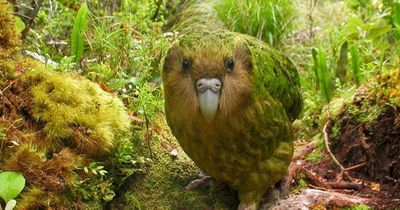My favorite "weird" but so cute animal is kakapo. It's a parrot that can't fly :3

In the animal kingdom, some parents go to hell and back when it comes to bringing their offspring into this world. Animals have many different ways of giving birth. Depending on the species, the offspring can weigh tons, or even come from the male. There are species where the mother even has a gestation period of more than 3 years! Yes, you read that right: she’s pregnant for 3 years...
Bright Side wants to show you 10 very unusual births from the animal kingdom. These examples show that the mothers and fathers of this Earth deserve the greatest recognition, because their efforts go further when it comes to securing their offspring.
The kiwi is one of the most peculiar birds found on Earth so far. One notable thing is that the male and female tend to be bound together for life, so they are said to be monogamous. Another peculiarity is the proportion between the weight of the egg and the body of the female. On average, a kiwi egg is 15% of the female’s body weight, but it can go up to 20%. Strangely enough, the male is in charge of incubating the egg and not the female. Unfortunately, this downy friend is on the brink of extinction.
The platypus is one of the few mammals that has the ability to lay eggs. After a gestation period of about 28 days, the female digs a burrow and deposits them there. She then incubates them for 10 days until they break the shell. The young platypuses then feed on their mother’s milk for about 3 or 4 months before leaving the burrow in search for food.
After 15 months, which is the normal gestation period for this species, female giraffes give birth while standing. Because of this, the newborns have to endure a steep 5-foot drop at the time of their birth. In as little as half an hour, they are supposed to be able to stand up, and after around 10 hours, they are running alongside their mothers.
An adult humpback whale can grow to be between 48 to 62.5 feet long and weigh an average of 40 tons. The gestation period of this species is about 11 months, and the calves can measure up to 4 meters and weigh up to 1.5 tons. Immediately after birth, the calves are able to swim. But the strangest part comes now. They are expected to accompany their mothers on a 3,000 mile trip in search for food only 6 weeks after their birth.
The Suriname Toad (Pipa pipa) is a leaf-like amphibian that lives in the jungles of South America. To reproduce, male toads deposit fertilized eggs on the female’s back. After a while, the female’s skin grows around them to cover them. The hatchlings-to-be develop over a period of 4 months, and when they finally hatch from the female’s back, they are actually fully formed toads.
Seahorses are monogamous and couples tend to stay together for life. This unique animal is one of the few species in which the male is in charge of incubating the eggs until they hatch. During mating, the females deposit them in an abdominal pouch held by the males. Later, males fertilize and incubate the eggs and give birth to many tiny seahorses. So when you see a “pregnant” seahorse, it means it’s a male.
It’s no secret that female kangaroos have a pouch on their belly, formed by a fold of skin. This pouch is meant to help them complete their babies’ (called joeys) formation. Newborns are approximately one inch long, so they are pretty small and vulnerable. The joeys are fed with mother’s milk during the first months. Around the fourth month, they come out of the pouch to take little trips and eat grass. And by the time they turn 10 months old, these youngsters are mature enough to leave the comfort of the pouch forever.
Cichlids are one of the largest families of vertebrate fish in the world. Many of their species keep their eggs in their mouths to ensure they have a greater chance of survival. That’s why they are called mouthbrooders. The process goes more or less like this: when it’s time for them to mate, the female lays the eggs and picks the whole fry up with her mouth. Then, the males fertilize them and the incubation lasts approximately 7 days. During this time, since the mother-to-be has her mouth full of eggs, she’s unable to feed herself until the babies are born.
The cuckoo catfish (whose scientific name is Synodontis multipunctatus, but we clearly prefer calling him the multipunk) has the amazing ability to hide its own eggs among those of the cichlid we mentioned in the previous point. All this happens in the few seconds left between the time that the female cichlid lays her eggs and the time that she bends over to “eat” them. Because the multipunk’s eggs grow and hatch faster than others (2 to 3 days maximum), the newborns often eat the cichlid’s eggs, which take about 7 days to hatch.
Imagine being pregnant for 3 and a half years! That’s exactly what happens to the frilled shark... Unlike other species, this one gives birth to live babies instead of laying eggs. Frilled sharks (also known by the fancy name of Chlamydoselachus anguineus) have between 2 and 15 babies. They hatch from their egg capsules inside the mother’s womb and remain there for up to 42 months...
Do you know of other animals that have unique pregnancies or births?
My favorite "weird" but so cute animal is kakapo. It's a parrot that can't fly :3












